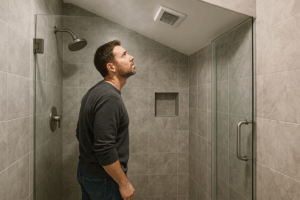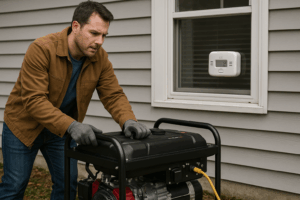Experiencing a flood in your commercial building can be a devastating event, leaving you facing numerous challenges. Whether it’s a high-rise, multifamily complex, mixed-use building, retail space, or office building here in Austin, the impact of commercial flood damage can be extensive and multifaceted. We’re here to guide you through essential steps and provide information to help you navigate the aftermath of a flood effectively.
Austin’s unique geography and unpredictable weather patterns make it particularly vulnerable to flooding. Whether caused by heavy rain, burst pipes, or water leaks, a flood can severely affect your commercial property. Acting quickly and efficiently is crucial to mitigate property damage and ensure safety.
Let’s walk through the steps you should take to manage flood damage in your property.
Flood Risks in Austin
Austin’s location and climate make it particularly vulnerable to flooding. The city’s proximity to rivers and creeks, combined with intense rainfall events, often results in flash floods. Additionally, urban development has increased impervious surfaces, reducing the ground’s ability to absorb water and exacerbating flood risks. Understanding these risks is essential for effective flood preparation and response.
Types of Flooding:
- Flash Flooding: Sudden, intense floods typically caused by heavy rainfall. These can occur with little warning and have severe impacts on both property and safety.
- River Flooding: This occurs when water levels in rivers and creeks rise due to prolonged rainfall or upstream water flow, potentially affecting areas along the banks.
- Urban Flooding: Caused by inadequate drainage systems in urban areas, leading to water accumulation in streets and buildings.
Flood Zones:
The Federal Emergency Management Agency (FEMA) maps out flood zones, indicating areas at varying levels of flood risk. Properties in high-risk zones, known as Special Flood Hazard Areas, are more likely to experience flooding and may have higher insurance premiums.
Assessing the Situation
When your commercial property is flooded, your first priority must be the safety of everyone inside. Here’s how to get started:
- Prioritize Safety of Occupants:
- Ensure that everyone, including tenants, employees, and customers, is evacuated safely.
- Check for any immediate hazards, such as electrical risks, structural damage, or contaminated water, and address them promptly.
- Determine Extent of Damage:
- Conduct a thorough inspection to understand how much of your property is affected.
- Take note of areas with significant water accumulation, visible damage to structures, and any possessions or equipment that may have been impacted. Look out for specific issues such as hot water pipe bursts or sprinkler system failures.
- Evaluate the Status of Utilities:
- Assess whether utilities like electricity, gas, and water are safe to use or if they need to be shut off to prevent further damage and hazards.
- Coordinate with local utility companies to manage these systems safely.
Gathering Essential Information
Having all the necessary information at hand will streamline your process of addressing flood damage.
- Insurance Details:
- Contact your insurance company immediately to report the flood damage.
- Review your insurance policy to understand what is covered and the steps required for filing a claim. Be aware of terms like actual cash value and coverage under the National Flood Insurance Program (NFIP). Austin participates in the NFIP, which means local businesses can and should consider obtaining this coverage.
- Commercial flood insurance is essential to protect against financial losses due to flood damage.
- Tenant Information:
- Compile a list of all tenants and their contact information.
- Keep tenants informed about the status of the building and any safety instructions.
- Emergency Contacts:
- Maintain a list of emergency contacts, including local authorities, medical services, and emergency contractors.
- Financial Assessment:
- Assess the financial impact of the flood, including potential revenue losses and repair costs.
- Explore any available financial assistance or disaster relief programs specific to Austin. Check if your insurance program, NFIP, or business interruption insurance can cover some of these losses.
Immediate Actions
Taking swift action is crucial to mitigating further damage and beginning the recovery process.
- Document the Damage:
- Take detailed photographs and videos of all affected areas to provide evidence for insurance claims and repair estimates.
- Keep records of communications with insurance providers and contractors.
- Communicate with Tenants:
- Provide regular updates to tenants about the status of repairs and any temporary accommodations if necessary.
- Address any concerns or questions promptly to maintain good tenant relations.
- Activate Emergency Response Plan:
- Implement your building’s emergency response plan, outlining specific steps to take during a flood.
- Ensure that all staff members are aware of their roles and responsibilities during the recovery process.
- Seek Professional Help:
- Engage professional restoration services, like us at All Nation Restoration, to handle the cleanup and repair work.
- Our team has the expertise and equipment to efficiently address commercial water damage, reducing downtime and preventing further issues like mold growth.
Long-Term Recovery
After addressing the immediate aftermath of the flood, the focus shifts to long-term recovery and prevention.
- Repair and Restoration:
- Work with contractors to repair structural damage, replace damaged materials, and restore your property to its pre-flood condition.
- Ensure all repairs meet local building codes and safety standards.
- Preventive Measures:
- Consider installing flood barriers, sump pumps, and other flood prevention systems to protect your property from future flooding.
- Regularly inspect and maintain plumbing and drainage systems to prevent leaks and overflows.
- Insurance Review:
- Review and update your insurance policy to ensure adequate coverage for flood damage.
- Consider additional coverage options if your property is in a high-risk flood zone. Be aware that the NFIP provides up to $500,000 for building coverage and $500,000 for contents coverage, which may not be sufficient for all properties, necessitating additional private flood insurance.
- Tenant Communication and Support:
- Continue supporting tenants during the recovery process by providing updates and addressing their needs.
- Offer assistance to tenants who may need to relocate temporarily.
- Business Continuity Planning:
- Develop or update your business continuity plan to prepare for future emergencies.
- Include strategies for maintaining operations during and after a disaster, such as remote work arrangements and temporary relocation options.
Expert Guidance for Flood Recovery
Dealing with flood damage in your commercial building presents numerous challenges, but with the right approach, you can effectively manage this difficult time. Preparedness and swift action are crucial in minimizing damage and ensuring a smooth recovery process.
At All Nation Restoration, we understand the complexities of handling flood damage in Austin commercial properties. Our team is ready to provide professional assistance to restore your building to its original condition. Contact us today to learn more about how we can help you.
Secure Your Commercial Property with All Nation Restoration
Don’t wait for the next disaster to strike. Contact All Nation Restoration today to learn more about our comprehensive flood damage restoration services for commercial properties. Share this post with fellow property owners to spread awareness and preparedness.
By following these guidelines and taking proactive steps, you can minimize the impact of flooding and ensure a quicker, more efficient recovery. Whether your property is a high-rise office, a multifamily complex, a mixed-use building, or a retail space, having a plan in place and knowing the right actions to take can make all the difference.
When your commercial property is flooded, it can lead to significant financial losses and operational disruptions. However, with our support and a well-structured response plan, you can protect your investment and ensure the safety and well-being of your tenants and employees. All Nation Restoration is here to help you every step of the way, offering expert advice and professional services tailored to your specific needs.
Remember, the key to handling flood damage in a commercial building is preparation, swift action, and ongoing support. By staying informed and taking proactive measures, you can minimize the impact of floods and safeguard your property for the future.
Helpful Resources
Here is some information and guidance on flood preparedness, emergency response, and recovery efforts so you have access to the tools and information needed to manage flood-related challenges effectively.







